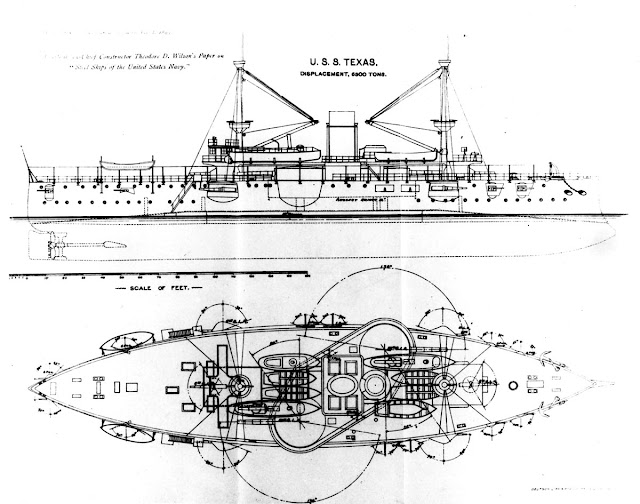 |
USS Texas, depicted in a Koerner & Hayes print made between 1897 or 1989 (Naval History and Heritage Command Image via Flickr).
|
By Jerome Kirkland
Hampton Roads Naval Museum Educator
Both USS Texas and USS Maine were authorized by Congress in August of 1886 as second class battleships. “Second class” meant the ship was meant more for coastal defense rather than as an oceangoing battleship meant to take the fight to a foreign country. Although USS Maine was originally meant to be an armored cruiser, this role changed during the construction process, resulting in two “near” sister ships. Maine and Texas represented the latest in battleship construction at the time of their design and early construction, but delays in their completion resulted in outdated ships by their commissioning nine years later. Chief among the “advanced” design elements that became outdated by their launch was the “en echelon” placement of the main gun turrets. This meant that for USS Texas, the forward turret was placed to the port (or left) of the centerline, while her aft turret was placed to starboard (or right), and not centered like on modern ships.
 |
| USS Texas postcard by the Rotograph Company of New York (Hampton Roads Naval Museum Collection). |
This
apparent hex would be dispelled by her service in the Spanish-American War. At the
start of the war there was fear that the Spanish fleet might attack the east
coast of the United States. This
resulted in the formation of the “Flying Squadron,” based out of Hampton Roads,
which would be able to respond if the Spanish fleet showed up. When it became apparent that the Spanish fleet
was in Cuban waters, USS Texas--along
with the rest of the Flying Squadron--was dispatched to Cuba. Here the battleship played a key role in defeating
the Spanish fleet at the Battle of Santiago de Cuba. Engaging several Spanish ships, including the
armored cruiser Vizcaya, she did much
damage while taking only one hit from a 6-inch gun.
After
the war several attempts to modernize her were made, but by 1911 USS Texas was simply too outdated. She was renamed the San Marcos in order to free up the name Texas for a new modern battleship under construction. In 1911, now named the San Marcos, she was towed to shallow waters in the Chesapeake Bay for
use as a target to test the effectiveness of newer guns. USS New
Hampshire (BB-25), a Connecticut-class
battleship commissioned in 1908, made several passes even after San Marcos settled on the muddy bottom
with her deck still above the waves. The
results from this test helped the Navy understand the relationship between
armor and modern guns. San Marcos continued to be used as target
practice through the post-WWII years.
 |
| Inspecting damage to the San Marcos armor after gunnery tests (Historic Ships blog). |
After
being sunk in the Chesapeake, San
Marcos/Texas continued to rack up the “hits,” with at least seven ships
damaged and at least three confirmed sinkings. This post-service record far exceeded her
wartime record. Unfortunately, these
were all commercial and private vessels that ran into her because she was not
visible beneath the surface. This
prompted the Navy to use explosives to force her down into the mud at
least 30’ below the surface in 1959.
Although
USS Texas was outdated by the time
she was launched, she was vital to the development of our modern steel Navy. The
lessons learned in her construction and from her sinking supplied vital
information in developing steel battleships. Her service in war and as a target gave many
lessons in effective combat skills.
For more about the sinking of San Marcos, please see Norfolk Naval Shipyard's History Matters blog post on the subject.
This post was written by Hampton Roads Naval Museum Educator Jerome Kirkland.






No comments:
Post a Comment